Key Takeaways
- A Web3 wallet is a crypto wallet that enables secure management of digital assets, facilitating participation in DeFi services;
- With advanced encryption, Web3 wallets offer users complete control over their funds, ensuring protection against unauthorized access;
- Supporting diverse cryptocurrencies and dApps, Web3 wallets provide effortless access to the expanding world of blockchain services for trading, governance, and more.
Free Airdrop Season 7 is LIVE! Answer fun questions or do simple tasks to earn rewards from the $30K BitDegree prize pool. Participate Now ! 🔥
Have you ever asked yourself questions like, "What is a Web3 wallet?", "Why do people talk about this like it's a big deal?" or even wondered, "How to create a Web3 wallet?". If so, you're the one I'm writing for.
Picture a digital universe where you're in charge, where owning your online space feels as real as holding a physical key. That's the promise of Web3 crypto wallets, the new frontier in online ownership.
Web3 crypto wallets can be hot (like the Coinbase wallet), cold (like the Ledger Nano X), MPC (like Zengo), and so on. So, let's dive into the question of what is a Web3 wallet and understand why this concept is becoming essential in the digital landscape.

Did you know?
Subscribe - We publish new crypto explainer videos every week!
What is Uniswap? (UNI Token Explained With Animation)


Table of Contents
What Is a Web3 Wallet?
In the vast online world, "What is a Web3 wallet?" is a question that pops up all the time. While the term "Web3 wallet" might sound like tech jargon, it's actually pretty simple. Think of it as a digital pocket where you can store all sorts of stuff related to your online life.
Latest Deal Active Right Now:Valentine's Day offer: save up to 50% on ALL best-selling Trezor bundles! Don't miss this sale & secure a huge discount now.
You know how you have a wallet to keep your cash, cards, and important IDs safe? A Web3 wallet does a similar job, but for your online assets in this new era of the internet.
What is a Web3 wallet capable of storing, exactly? It holds your usual cryptocurrencies like Bitcoin, Ethereum, and so on. Plus, it stores things like your digital collectibles or even those unique tokens you might earn by participating in online communities. Basically, it’s the guardian of your online valuables.
But what makes it stand out? Well, it's all about this revolutionary concept called Web3.
Web3 is like the new and improved internet. It's all about putting you in control. Instead of big companies owning and controlling your data, Web3 aims to give you the power to manage and own your stuff online[1]. That's where the Web3 wallet swoops in – it’s your personal gateway to this new era of internet freedom.
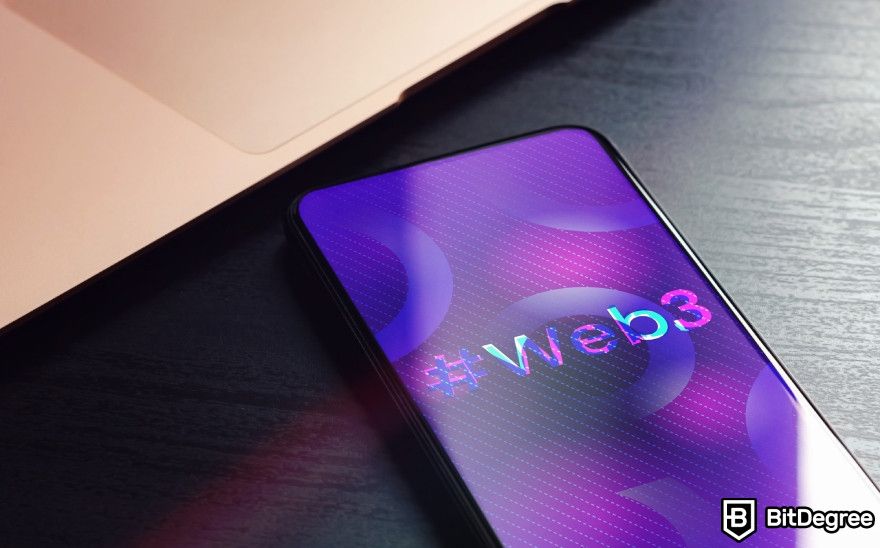
One of the coolest parts? With Web3, you’re not just holding onto your digital goods, because you’re also able to interact with all sorts of decentralized apps (dApps). These dApps can be anything from virtual art galleries to platforms where you can trade unique digital items. And your Web3 wallet? It’s like the master key that unlocks access to these cool places.
Alright, but why should you care about all this? Well, imagine having full control over your online assets and data. With a Web3 wallet, you’re not just a user anymore; you're an owner. Plus, it’s all about security and freedom. Your data is safer, and you have more say in how it’s used.
So, in a nutshell, what is a Web3 wallet? It's your digital guardian in the new internet landscape. It keeps your digital goodies safe and gives you the keys to a world where you’re more in control.
Web3 Wallet VS Crypto Wallet
If you're still not sure what is a Web3 wallet and how it differs from a traditional crypto wallet, let me explain.
At first glance, the terms might seem interchangeable, but there are nuances that set them apart. Let's start with the basics.
A crypto wallet, short for cryptocurrency wallet, primarily deals with storing and managing digital currencies like Bitcoin or Ethereum. It's your digital vault for holding these cryptocurrencies securely. Think of it as your wallet in the digital realm, but instead of physical cash, it stores digital coins or tokens.
On the other hand, a Web3 wallet expands beyond just cryptocurrencies. It's like a Swiss Army knife for the decentralized web. While it can handle cryptocurrencies like a traditional crypto wallet, it goes a step further by allowing you to manage various digital assets and interact with decentralized applications.

Besides, while both Web3 wallets and traditional cryptocurrency wallets prioritize security, Web3 wallets often implement additional security measures to protect users' privacy and funds in the context of decentralized applications.
In essence, the distinction between these wallets lies in their scope and functionality. A crypto wallet focuses mainly on managing cryptocurrencies, while a Web3 wallet is a more comprehensive tool that enables participation in the evolving decentralized ecosystem.
So, every Web3 wallet is a crypto wallet, but not every crypto wallet is a Web3 wallet.
How Do Web3 Wallets Work?
Let's look a bit deeper into the processes that happen in a Web3 wallet.
Web3 wallets act like secure digital vaults for your access keys to the blockchain and cryptocurrencies. When you set up a Web3 crypto wallet, you're essentially creating a vault that holds the keys needed to prove you own your digital assets.
It all starts with the creation of your account and the assignment of a public and private key, as well as the creation of a seed phrase.
A seed phrase is super important. Losing it could mean losing access to your assets forever. That's why any "how to create a Web3 wallet" guide will insist you jot down your seed phrase and keep it offline in a safe place.
However, the real magic lies in how these wallets handle your keys. They generate a pair of keys – a public key and a private key – using complex mathematical algorithms. The public key gets hashed and turns into a public address, where people can send transactions to you.

Your wallet’s public address is like your digital identity tag. Here’s a cool tip: some wallets let you attach this address to a decentralized name service. For instance, on Ethereum, you can link your wallet to an .eth domain through the Ethereum Name Service (ENS). This makes it easier for others to remember and interact with your wallet by using a simple domain name instead of a long string of numbers and letters.
The private key, on the other hand, is your super-secret key that signs transactions and proves you own your digital goodies. Keeping that private key safe is crucial because anyone who gets their hands on it gains access to your digital assets.
Once you're logged into your Web3 wallet, you get a clear view of what digital assets you've got stored in there. From that point, you can send or receive digital assets to and from other wallet addresses.
However, as you already know, Web3 wallets are not just about moving assets around. They can also interact with dApps, which are like decentralized versions of traditional apps you might use every day.

These dApps run on blockchain networks and offer a wide range of functionalities, including DeFi services like lending and borrowing, DEXs and CEXs for trading cryptocurrencies, NFT marketplaces for digital collectibles, decentralized social networks, gaming platforms, and many more.
Now, do note that Web3 wallets are all about giving you control – and that's why many of them are self-custody solutions. This means you hold your private keys and have the power to make transactions the way you want, without too many restrictions.
Still, for those new to the crypto space, custodial Web3 wallets are a thing, too – like the Bybit wallet. However, more on custodial VS non-custodial wallets later.
Lastly, it must be mentioned that security is a big deal for Web3 wallets. They use fancy encryption techniques to protect your private keys. Some even offer extra security layers like multi-factor authentication or biometric verification to keep unwanted visitors out.
Types of Web3 Wallets
Now that you have the answer to the "what is a Web3 wallet" matter, it's time to get even deeper into the intricate workings of these digital marvels, exploring Web3 wallet types as well as weighing their advantages and drawbacks.
So, what is a Web3 wallet's main priority, and what are its features?
As I said before, Web3 wallets come in various shapes and sizes, catering to different needs and experiences of users tapping into the blockchain.
First up, there's the divide between hot wallets and cold wallets.
Hot Wallets
Hot (software) wallets are connected to the internet, providing easy access for managing funds but are more vulnerable to security threats. They're perfect for small, frequently traded amounts of crypto.
Hot wallets can be desktop wallets, residing on your computer or laptop, browser extension wallets, which are downloaded as plug-ins on your browser, or mobile wallets, designed for smartphones or tablets. They're handy but considered less secure compared to cold wallets.
| PROS | CONS |
|---|---|
| Instant access to funds for quick transactions. | Vulnerable to online hacks or cyberattacks. |
| Intuitive interfaces for easy navigation. | Users entrust private keys to online servers. |
| Integration with various platforms and services for enhanced functionality. | Susceptible to loss if the hosting platform experiences downtime or closure. |
Table: Pros and cons of hot wallets.
Cold Wallets
Now, cold wallets take security up a notch. They're offline, making it harder for hackers to breach. Typically, these are hardware wallets, which are physical devices that often look like USB drives. Cold wallets are the go-to for long-term storage of substantial crypto amounts.
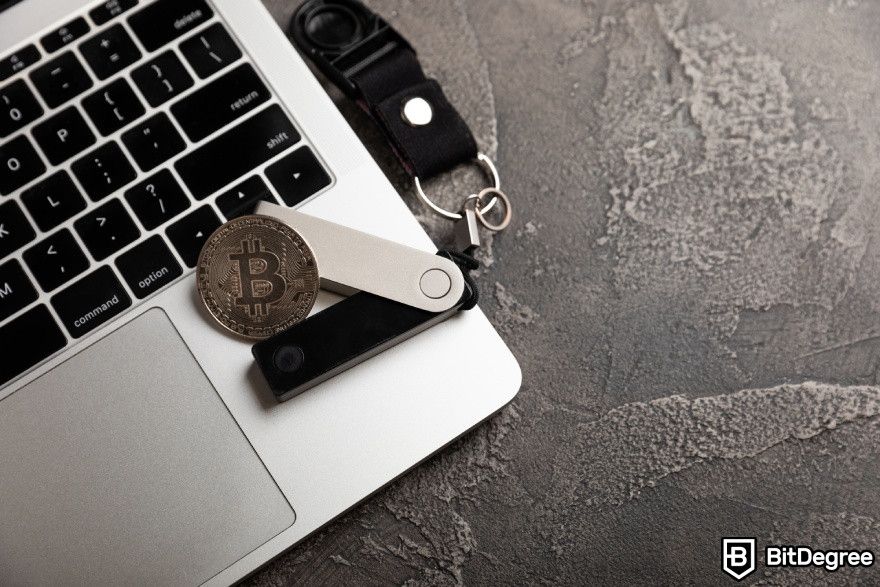
There are also paper wallets, which actually means exactly what it sounds like – your wallet is a piece of paper. Well, okay, not the actual paper, but the private and public keys that are printed out on it. While these wallets offer strong security, they are not very convenient as Web3 wallets.
| PROS | CONS |
|---|---|
| Offline storage minimizes hacking risks. | Less convenient for frequent transactions. |
| Users retain full control over funds. | Requires technical know-how. |
| Ideal for securely holding large amounts. | Hardware loss may lead to fund loss. |
Table: Pros and cons of cold wallets.
Moving on, when it comes to podering what is a web3 wallet, you must understand the distinction between non-custodial wallets and custodial wallets.
Non-Custodial Wallets
Non-custodial (or self-custodial) wallets put you in charge of your private keys, granting full control over your funds without any third-party involvement. These can be hot or cold wallets, ensuring high security by eliminating the risk of third-party breaches. Most Web3 wallets are non-custodial.
| PROS | CONS |
|---|---|
| Full control over private keys and funds. | Users are solely responsible for the security and management of their funds. |
| Reduced risk of hacking or third-party breaches. | Forgetting private keys can result in irreversible loss of funds. |
| Users can maintain anonymity without sharing personal information. | Requires understanding of private key management and security practices. |
Table: Pros and cons of non-custodial wallets.
Custodial Wallets
Custodial wallets, on the flip side, involve entrusting a third party, such as a cryptocurrency exchange or wallet service provider, with the custody and control of your private keys.
While custodial wallets offer convenience and ease of use, allowing users to access their funds through a user-friendly interface and often providing additional features like customer support and account recovery options, they come with inherent risks.
One of the most significant drawbacks is the relinquishment of control over one's funds and the dependency on the custodial service to safeguard them.
| PROS | CONS |
|---|---|
| Easy-to-use interfaces for beginners. | Users cede control of private keys. |
| Option for password retrieval. | Potential risk if the custodial service is compromised. |
| Seamless connection to other services. | Subject to regulations and privacy concerns. |
Table: Pros and cons of custodial wallets.
Email Wallets
Now, there's also the emerging concept of email wallets within the custodial category. They've gained attention for their seamless user experience, allowing sign-ups and management of Web3 wallets using email addresses.

They're great for newcomers, simplifying blockchain-based app usage without needing extensive crypto knowledge, but email accounts can be way too vulnerable.
| PROS | CONS |
|---|---|
| Streamlined user onboarding for Web3 apps. | Reliance on custodial services. |
| Easy sign-up and access using email addresses. | Security tied to email account vulnerabilities. |
| Suitable for users new to crypto. | Limited control over private keys. |
Table: Pros and cons of email wallets.
Smart Contract Wallets
Next, we have smart contract wallets, which operate on smart contracts, offering enhanced security features like social recovery and account freezing. They're programmable for added usability and safety.
But wait, what is a Web3 wallet with social recovery? Actually, what is social recovery?
Social recovery is a recovery method that helps when you forget passwords or keys[2]. Instead of relying only on memory or usual recovery procedures, it uses trusted contacts, like friends or family. They work together to help you regain access to your funds during emergencies.
| PROS | CONS |
|---|---|
| Enhanced security with programmable features. | Complexity in programming features. |
| Additional functionalities like social recovery. | Potential vulnerabilities in smart contract code. |
| Increased control and customization. | Need for understanding smart contract functionality. |
Table: Pros and cons of smart contract wallets.
MPC Wallets
Lastly, there are MPC wallets (Multi-Party Computation), an innovative solution where traditional private keys are replaced with multiple secret shares generated independently. In this approach, users maintain self-custody of their assets without the need to directly manage a single private key.

Instead, the private key is divided into multiple shares, distributed across different devices or parties, and reconstructed using cryptographic algorithms only when needed for transactions. This decentralized approach enhances security by reducing the risk of a single point of failure.
Even if one of the shares is compromised, the attacker cannot access the funds without obtaining the remaining shares. As a result, MPC wallets offer a compelling balance between security and usability, providing users with peace of mind while ensuring seamless access to their digital assets.
| PROS | CONS |
|---|---|
| Elimination of risks associated with losing private keys. | Potential reliance on multiple parties for security. |
| Enhanced security through secret sharing. | Complexity in understanding and implementing MPC concepts. |
| Simplified self-custody without key management worries. | Limited availability and adoption compared to other wallet types. |
Table: Pros and cons of MPC wallets.
Now, there are quite a few wallet types and it might get a tad confusing when trying to figure out what is a web3 wallet, right? These different wallet types cater to varied user preferences and security needs, offering a range of options to interact with the blockchain safely and conveniently.
To simplify it a bit for you, note that you mainly have to choose between a hot and cold wallet and then decide whether you want to go with a custodial or a non-custodial one.
Security and Control
What is a Web3 wallet if it's not properly secure? A true menace, right? Security and control play pivotal roles in the realm of Web3 wallets, shaping the way users interact with and safeguard their digital assets.
Decentralization stands tall as a cornerstone, fortifying the security measures within Web3 wallets. By dispersing data across a network rather than centralizing it, these wallets eliminate single points of failure, making them resilient against potential hacking or data breaches. This decentralized architecture fundamentally reduces risks, offering a robust shield for users' assets.
The allure of most Web3 wallets lies in the empowerment they bestow upon users. Unlike traditional centralized systems where control rests in the hands of intermediaries, non-custodial wallets allow users to wield complete ownership and control over their digital assets.
It's akin to having a vault that only they possess the keys to, ensuring autonomy and eliminating dependence on third-party entities.

Privacy and transparency, seemingly conflicting notions, find a delicate equilibrium within Web3 wallets, too. Privacy takes precedence, safeguarding sensitive user data, while transparency thrives through immutable transactions on the blockchain.
This delicate balance ensures that while transactions remain visible on the public ledger, individual user identities and details are shielded, fostering a secure yet transparent environment.
Ensuring the safety of your Web3 wallet involves a shared responsibility. While selecting a reputable wallet is crucial, users play a pivotal role in fortifying security. Opting for reputable wallets with strong encryption and robust security features, such as the Ledger Nano X and the Coinbase wallet, serves as a solid foundation.
Additionally, employing best practices like enabling two-factor authentication, regularly updating passwords, and safeguarding private keys are pivotal steps to fortify the fortress of your digital assets.
Remember, investing in cryptocurrencies not only demands a great Web3 wallet but also calls for an active role in maintaining its security. Your diligence fortifies the shield that guards your digital holdings in this decentralized landscape.
Top Web3 Wallets
Your quest to find out "what is a Web3 wallet" should include some knowledge about the current market out there, too. So, let me tell you about a few bit big names that stand out in the Web3 crypto wallet department.
Ledger Nano X
The Ledger Nano X is one of the leading hardware wallets renowned for its robust security features and user-friendly interface, making it ideal for Web3 applications. With its support for a wide range of cryptocurrencies and compatibility with various DeFi platforms, the Nano X ensures secure management and access to digital assets in the decentralized ecosystem.
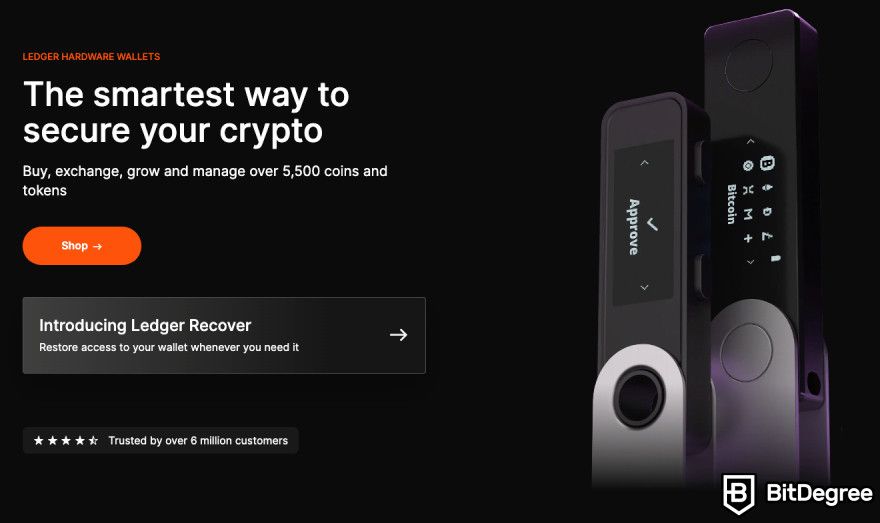
Its Bluetooth connectivity and mobile app enable convenient access to funds on the go, while its offline storage ensures protection against cyber threats. As a trusted choice among crypto enthusiasts, the Ledger Nano X stands out as a reliable solution for safeguarding and conveniently using assets in the Web3 era.
Coinbase Wallet
A popular choice known for its user-friendly interface, the Coinbase wallet offers a seamless (and completely free) experience for cryptocurrency management. It enables users to effortlessly manage a diverse range of cryptocurrencies using both the mobile app the the browser extension. Besides, its built-in access to dApps opens up a world of possibilities for users.

Additionally, its integration with the larger Coinbase ecosystem further enhances its appeal, offering seamless interoperability with other Coinbase services such as cryptocurrency trading, lending, and staking.

Did you know?
Subscribe - We publish new crypto explainer videos every week!
What is a Crypto Airdrop & How to Get FREE Coins? (Animated)



- User-friendly design
- Robust security
- Long battery life

- A brand-new design
- Industry-leading security
- Coin, token and NFT storage

- Supports 1,000+ crypto assets
- Easy navigation
- Open-source
MetaMask
MetaMask has earned its spot as one of the top Web3 wallets, primarily for its compatibility with a wide range of web browsers and mobile devices, and the fact that it's free to use. MetaMask enables users to securely store and manage their Ethereum-based assets while seamlessly navigating the decentralized web.

Though, while MetaMask is primarily known for its support of Ethereum-based dApps, it also offers compatibility with other blockchains, such as Binance Smart Chain, Polygon, and various EVM-compatible networks.
All in all, each of these wallets offers distinct features and functionalities, catering to various preferences and needs. Whether it's user-friendliness, extensive token support, or seamless integration with decentralized platforms, these wallets represent the forefront of Web3 innovation, empowering individuals to truly own and manage their digital assets online.
How to Create a Web3 Wallet?
What is a Web3 wallet going to do for you if you don't actually create it, right? That said, let's talk about how to create a Web3 wallet.
Don't worry, it's not as complex as it sounds. I'll take the Coinbase wallet as an example to walk you through the steps, but the process of creating other Web3 wallets is generally very similar, and just as simple.
Oh, and do note that this guide will follow the creation of a browser extension of the Coinbase wallet on Chrome, but you can also do that via the Brave browser or by installing the Coinbase wallet app on your mobile device (available for both Android and iOS).
Step 1: Begin by installing the Coinbase wallet extension from the Chrome Web Store. Look it up and hit [Add to Chrome].
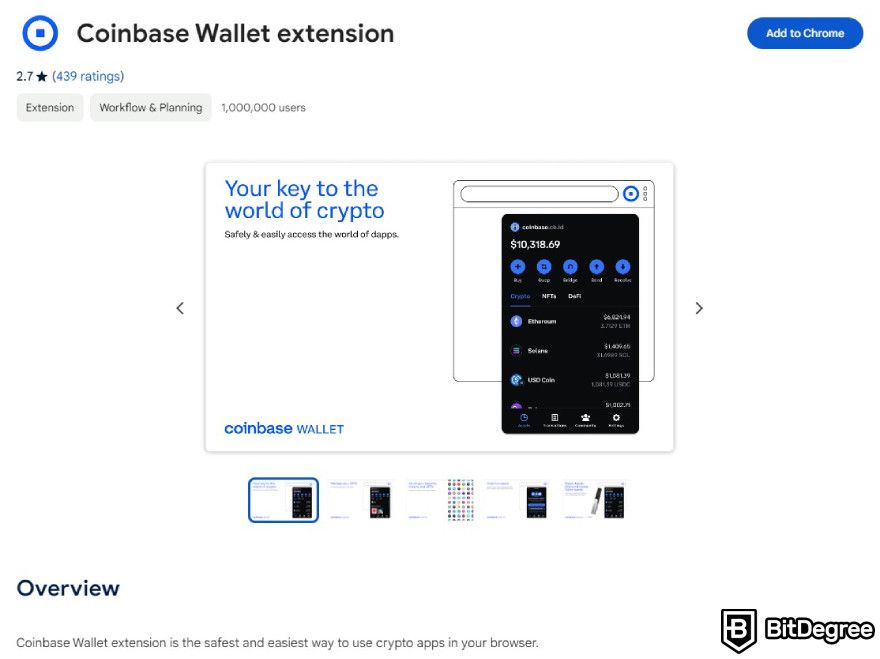
Step 2: Once installed, open the extension and select [Create new wallet].

Step 3: Securely back up a 12-word recovery phrase and then tap [Continue]. This phrase is crucial, serving as your access key to the wallet. Store it safely, like in a password manager or written down in a secure place. Remember, Coinbase can't retrieve this phrase for you and what is a Web3 wallet without access to it?

Make sure to confirm that you've saved the recovery phrase. Double-checking ensures you have a secure back up.
Step 4: Set a strong password to protect access to your wallet. Keep this password safe, as it will be your regular entry point. Similar to the recovery phrase, Coinbase can't help you recover a forgotten password. After typing in your password, read the terms and privacy policy. If you agree to them, check that box and hit [Submit].
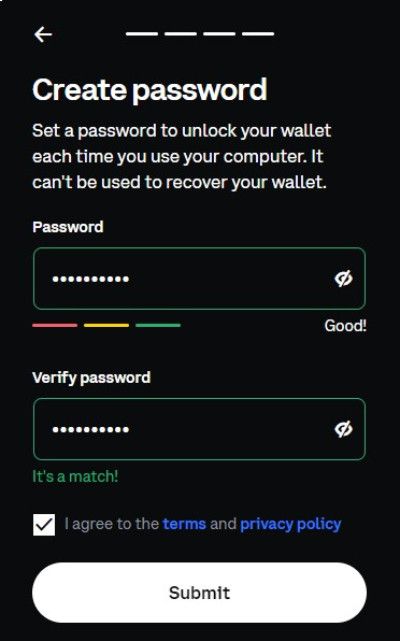
Step 5 (optional): Next, claim your unique Web3 username. This username allows other Coinbase wallet users to locate and send you crypto. If you want to skip this for now, you can do it later, too.

That's it, you're a proud owner of your very own Web3 wallet. So, next time someone hits you with a "what is a Web3 wallet" type of question, you can show them your brand new Coinbase wallet.
Conclusions
So, what is a Web3 wallet but the Swiss Army knife of crypto wallets? Now that you understand them, it's clear that they're not just another tech trend but a game-changer in how we navigate the digital realm. In a world where data is king, Web3 wallets are like your personal knights, guarding your online kingdom.
By embracing a decentralized approach, most Web3 wallets ensure that you call the shots, whether it's managing your digital assets, engaging in blockchain-based communities, or participating in decentralized finance. The days of relying on intermediaries are dwindling, making room for a more transparent and user-centric online experience.
As you navigate the ever-expanding landscape of Web3, remember that your wallet is not just a keeper of keys but a key player in reshaping the future of online ownership. So, be sure to stick with reputable ones, like the Ledger Nano X or the Coinbase wallet.
The content published on this website is not aimed to give any kind of financial, investment, trading, or any other form of advice. BitDegree.org does not endorse or suggest you to buy, sell or hold any kind of cryptocurrency. Before making financial investment decisions, do consult your financial advisor.
Scientific References
1. J. Bambacht, J. Pouwelse: 'Web3: A Decentralized Societal Infrastructure for Identity, Trust, Money, and Data';
2. A. Pedin, N. Siasi, M. Sameni: 'Smart Contract-Based Social Recovery Wallet Management Scheme for Digital Assets'.











